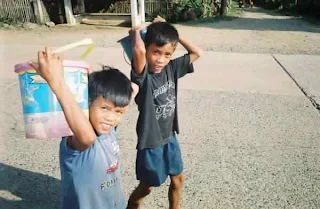Coming to Iloilo City in 2005, something immediately caught my attention.
Passing General Luna Street, I saw streamers and makeshift tents in front of the University of San Agustin. From friends and new acquaintances I would learn that the union employees of the university were protesting unlawful acts committed by the administration against them and their members.
For the succeeding months, I would see [and read] these streamers denouncing the administration for having been unjust to the employees who had served the university for a period of time; the streamers and protests also raised a number of other issues against the administration.
It was the first time I saw a dramatic interplay between two forces going on. I would see the same setup, up to the time the streamers became soiled and muddied that I could not read the words in them anymore, or that I found them annoying—because they would block my view of the university.
 But the sight only drew my attention and scrutiny.
But the sight only drew my attention and scrutiny.
Once, I saw a public meeting by a number of people in front of the university gates, rallying aloud for their concerns. From other people I would learn that the strike by the employees was without basis; and that some of them were reinstated in their service to the university; and that others were relieved from service.
It was only later—in the official statement of the university published in the local papers that the facts became clearer. The court finally denied the legality of the employees’ mobilization against the university.
Even before the court handed down its decision, a friend confided to me once how he pitied the union employees because despite legal assistance, their acts and even the subsequent measures they took were baseless, lacking ground and orientation.
It does not require anyone to be a lawyer to understand an issue like this. It is easy to articulate how and why these things are made of, only if we were more than observant.
For one, unrest in the labor sector might stem from people’s discontent. Administration, any status quo, for that matter, naturally defends itself because it normally conducts matters with much discretion and decorum, and utter deference to the people it serves—thus, its confidence in the manner of doing things is simply effortless.
Meanwhile, social realities like labor unrest do not fail to interest artists because they involve the dynamic interplay between elements in the society.
Scenarios like this must have given inspiration to age-old masterpieces as French naturalist Emile Zola’s Germinal, a turn-of-the-century novel about the miners’ unrest against their employers in a French coalmine. The same reminds me of Mike de Leon’s Sister Stella L., a film which looms large in the social realist genre.
 Artists, writers, film directors, and people of similar occupations can consider the subject for a more incisive study, so they can later put forth something from which people can learn and be inspired further.
Artists, writers, film directors, and people of similar occupations can consider the subject for a more incisive study, so they can later put forth something from which people can learn and be inspired further.
Such experiences merit a more incisive introspection, a careful study that renders more truth.
If rendered more truthfully, their act of writing—the work itself created after having been moved, inspired or bothered by these realities—can make persons out of individuals, or turn souls out of institutions.








